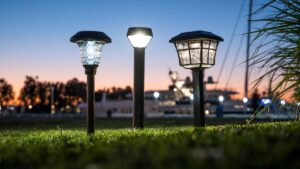Choosing the Right Type of Plastic for Outdoor Lighting
Choosing the right type of outdoor lighting can make all the difference in how your property looks and feels. You want fixtures that can withstand the harsh environmental demands of Nebraska weather and last for years, sometimes decades, to come.
Plastics are versatile and provide many advantages over wood, metal, and glass. Here are 3 of the best types for outdoor use.
Acrylic
Acrylic is a transparent plastic outdoor lights that can be used for many different lighting applications. It is commonly used for opal LED signs, as well as for a variety of other uses.
Acrylic is an excellent choice for outdoor lighting because it is weatherproof and UV-resistant. It is also highly impact resistant, making it safer than glass.
There are a number of ways to cut and sculpt acrylic. However, it is important to use professional-grade tools.
There are some special grades of acrylic sheet and film designed to diffuse LED hot spots without sacrificing light transmission. These are often engineered to meet stringent flammability requirements for aircraft and mass transit lighting.

High-Density Polyethylene (HDPE)
Often referred to as HDPE, high-density polyethylene is a common thermoplastic used for many outdoor lighting applications. It is slightly denser than low-density polyethylene (LDPE) but has a higher strength-to-density ratio, which allows it to withstand temperatures that LDPE can’t.
Compared with LDPE, which has long- and short-chain branching that prevents it from packing tightly into its crystalline form, HDPE has little branching and a linear structure that gives it strong intermolecular forces and tensile strength.
Because of this, it is ideal for injection molding and CNC machining. Its density ranges from 930 to 970 kg/m3 and it can withstand higher temperatures without cracking or warping. It is also resistant to common solvents, acids and corrosives and is recyclable. It is widely available in plastic furniture and automobile parts.
Polycarbonate
Polycarbonate is a tough, transparent plastic material with excellent strength and stiffness. This makes it a great choice for outdoor lighting applications.
It is used in the production of light-diffusing outdoor LED fixtures, sconces, signage, and other products. It can also be molded and thermoformed into complex shapes.
When processing polycarbonate, it is important to dry the material well before forming it. This usually means soaking the plastic in a 120 degree C oven for two to four hours.
Polycarbonate is compatible with many mineral acids, alcohols, mild soaps, petroleum oils (but not silicone oils or greases), and low concentrations of alkalis. However, halogenated solvents such as toluene, benzene, gasoline, and acetone can cause surface whitening and crystallization of the material.
Nylon
Nylon is one of the most versatile synthetic fibers in the world. It’s found in everything from raincoats to swimwear to underwear.
It’s also a popular material for machinery parts and equipment. It can be used for bushings, fittings, rivets, threaded components, and washers.
When injection molding, nylon is often filled with a glass fiber fill to increase its strength and impact resistance. However, this increases the amount of bending that occurs during failure, which can lead to damage.
Synthetic fabrics like nylon are not biodegradable or compostable and they have a devastating impact on our environment. It takes hundreds of years for them to decompose, releasing toxic chemicals and greenhouse gases into the air.
Copper
Outdoor copper lighting is one of the most stylish and durable options available. The metal doesn’t rust and is almost impervious to extreme weather, which makes it ideal for use on a patio or other outdoor areas.
It’s also eco-friendly, as it can be recycled after the lighting fixture has served its purpose. This is important because it helps reduce exploitation of natural resources and protect the environment.
Another plus to choosing copper is that it will change color over time, a process called patina. This natural process adds a unique touch to lanterns, sculptures and other copper fixtures that are used outdoors.